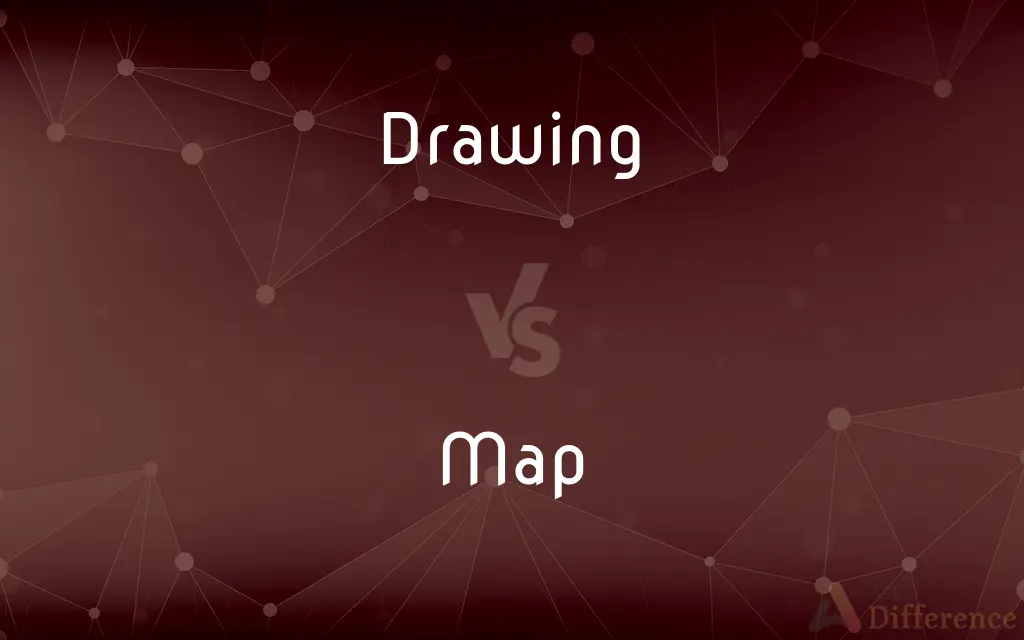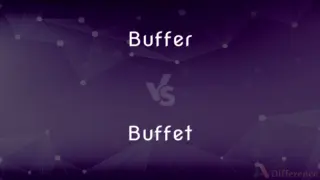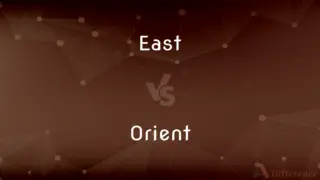Drawing vs. Map — What's the Difference?
By Tayyaba Rehman & Fiza Rafique — Updated on March 19, 2024
A drawing is a visual representation created by hand or digitally, focusing on artistry or design, while a map is a visual representation of an area, designed to display geographical features and relationships.

Difference Between Drawing and Map
Table of Contents
ADVERTISEMENT
Key Differences
Drawings encompass a wide range of visual art forms, from sketches and illustrations to detailed designs and plans. They can be abstract, realistic, or stylized, serving purposes from artistic expression to technical specification. Maps, in contrast, are specifically designed to represent geographical areas, detailing physical land features, political boundaries, and other spatial relationships to aid navigation and understanding of a location.
The creation of a drawing can involve various materials and techniques, such as pencil, ink, charcoal, or digital tools, depending on the artist's intention and style. Maps are also created using diverse methods, including GIS (Geographic Information Systems) for precision and detail, but their primary goal is to accurately convey information about a place, rather than artistic expression.
Drawings are subjective and can be interpreted in multiple ways based on the viewer's perspective and the artist's intent. Maps, however, strive for objectivity and clarity, using established symbols and scales to provide a universally understandable representation of geographic data.
While drawings may capture emotions, concepts, or imaginative scenarios, maps are rooted in factual and empirical data. Maps serve practical purposes such as planning travel routes, understanding territorial distributions, or analyzing environmental changes, whereas drawings might not have a practical application beyond the aesthetic or conceptual.
The skill set for creating drawings versus maps can overlap, especially in areas like draftsmanship and design, but mapmaking requires specific knowledge of geography, cartography, and possibly data analysis. Artists and designers might focus more on developing their visual and creative skills, exploring different mediums and styles to express ideas or create visual solutions.
ADVERTISEMENT
Comparison Chart
Purpose
Artistic expression or design.
Representation of geographical areas.
Focus
Artistry, design, imagination.
Geographical features, navigation.
Interpretation
Subjective, varies with viewer's perspective.
Objective, uses standardized symbols.
Creation Methods
Pencil, ink, charcoal, digital tools.
GIS, digital tools, cartographic techniques.
Function
Aesthetic, conceptual, or design-focused.
Practical, informational, navigational.
Compare with Definitions
Drawing
A form of visual art expressed through lines on a surface.
The artist's drawing captured the emotion of the scene beautifully.
Map
Used for navigation, planning, and understanding geographical areas.
Tourists rely on city maps to find major attractions.
Drawing
Serves as a fundamental skill in various art and design fields.
Architects begin their projects with detailed drawings of plans.
Map
Essential in fields like urban planning, geography, and environmental science.
Urban planners use maps to design efficient city layouts.
Drawing
Often reflects personal style and creative intent.
His drawings are easily recognizable by their distinctive line work.
Map
Can depict physical, political, or thematic data.
The climate map showed average temperatures across regions.
Drawing
Utilized in storyboarding, concept art, and illustration.
The film's concept art was developed through a series of detailed drawings.
Map
A graphical representation of a space that emphasizes relationships between elements.
The hiking map displayed all the trails and their difficulty levels.
Drawing
Can be abstract or realistic, based on imagination or observation.
Her abstract drawings challenge our perceptions of reality.
Map
Incorporates symbols and scales for accuracy and comprehension.
The map's legend explained the symbols for roads, trails, and rivers.
Drawing
Drawing is a form of visual art in which an artist uses instruments to mark paper or other two-dimensional surface. Drawing instruments include graphite pencils, pen and ink, various kinds of paints, inked brushes, colored pencils, crayons, charcoal, chalk, pastels, erasers, markers, styluses, and metals (such as silverpoint).
Map
A map is a symbolic depiction emphasizing relationships between elements of some space, such as objects, regions, or themes. Many maps are static, fixed to paper or some other durable medium, while others are dynamic or interactive.
Drawing
The act or an instance of drawing.
Map
A representation, usually on a plane surface, of a region of the earth, intended primarily to provide information about the relative location or nature of features within that region.
Drawing
The art of representing objects or forms on a surface chiefly by means of lines.
Map
A similar representation of a region of the sky or of a celestial object
A map of the constellations of the southern hemisphere.
Drawing
A work produced by this art.
Map
Something that suggests such a representation, as in clarity of representation
A map of the human genome.
Drawing
Present participle of draw
Map
(Mathematics) The correspondence of elements in one set to elements in the same set or another set.
Drawing
A picture, likeness, diagram or representation, usually drawn on paper.
Map
(Slang) The human face.
Drawing
The act of producing such a picture.
Map
(Genetics) A genetic map.
Drawing
Such acts practiced as a graphic art form.
Map
To make a map of.
Drawing
The process of drawing or pulling something.
Proverb: An official is great in his office as a well is rich in drawings of water.
Map
To depict as if on a map
Grief was mapped on his face.
Drawing
An act or event in which the outcome (e.g., designating a winner) is selected by chance in the form of a blind draw, notably of lots; especially such a contest in which a winning name or number is selected randomly by removing (or drawing) it from a container, popularly a hat.
Map
To explore or make a survey of (a region) for the purpose of making a map.
Drawing
A small portion of tea for steeping.
Map
To plan or delineate, especially in detail; arrange
Mapping out her future.
Drawing
The act of pulling, or attracting.
Map
(Genetics) To locate (a gene or DNA sequence) in a specific region of a chromosome in relation to known genes or DNA sequences.
Drawing
The act or the art of representing any object by means of lines and shades; especially, such a representation when in one color, or in tints used not to represent the colors of natural objects, but for effect only, and produced with hard material such as pencil, chalk, etc.; delineation; also, the figure or representation drawn.
Map
(Mathematics) To establish a mapping of (an element or a set).
Drawing
The process of stretching or spreading metals as by hammering, or, as in forming wire from rods or tubes and cups from sheet metal, by pulling them through dies.
Map
A visual representation of an area, whether real or imaginary, showing the relative positions of places and other features.
A map of Australia, a map of Lilliput
Drawing
The process of pulling out and elongating the sliver from the carding machine, by revolving rollers, to prepare it for spinning.
Map
A graphical or logical representation of any structure or system, showing the positions of or relationships between its components.
A map of the Earth's magnetic field
Drawing
The distribution of prizes and blanks in a lottery.
Map
(mathematics) A function. Category:en:Functions
Let be a map from to
Drawing
An illustration that is drawn by hand and published in a book or magazine;
It is shown by the drawing in Fig. 7
Map
(entomology) Any of various nymphalid butterflies of the genera Araschnia (especially, Araschnia levana) and Cyrestis, having map-like markings on the wings.
Drawing
A representation of forms or objects on a surface by means of lines;
Drawings of abstract forms
He did complicated pen-and-ink drawings like medieval miniatures
Map
The face.
Drawing
The creation of artistic drawings;
He learned drawing from his father
Map
An imaginary or fictional area, often predefined and confined, where a game or a session thereof takes place.
I don't want to play this map again!
Drawing
Players buy (or are given) chances and prizes are distributed according to the drawing of lots
Map
(computing) associative array.
Drawing
Act of getting or draining something such as electricity or a liquid from a source;
The drawing of water from the well
Map
(transitive) To represent by means of a map.
This large atlas maps the whole world in very great detail.
Figure 3 maps the pressure distribution within the human circulatory system.
Drawing
The act of moving a load by drawing or pulling
Map
(transitive) To create a map of; to examine or survey in order to gather information for a map.
The team is mapping the route of the new railway line.
The space probe is mapping the Earth's gravitational field.
This equipment is designed to map the neurons of the human brain in three dimensions.
Map
To have a direct relationship; to correspond.
This doesn't map to my understanding of how things should work.
Map
To create a direct relationship to; to create a correspondence with.
Map
To act as a function on something, taking it to something else.
maps to , mapping every to .
Map
To assign a drive letter to a shared folder.
Map
A representation of the surface of the earth, or of some portion of it, showing the relative position of the parts represented; - usually on a flat surface. Also, such a representation of the celestial sphere, or of some part of it.
Map
Anything which represents graphically a succession of events, states, or acts; as, an historical map.
Thus is his cheek the map of days outworn.
Map
To represent by a map; - often with out; as, to survey and map, or map out, a county. Hence, figuratively: To represent or indicate systematically and clearly; to sketch; to plan; as, to map, or map out, a journey; to map out business.
I am near to the place where they should meet, if Pisanio have mapped it truly.
Map
A diagrammatic representation of the earth's surface (or part of it)
Map
A function such that for every element of one set there is a unique element of another set
Map
Make a map of; show or establish the features of details of;
Map the surface of Venus
Map
Explore or survey for the purpose of making a map;
We haven't even begun to map the many galaxies that we know exist
Map
Locate within a specific region of a chromosome in relation to known DNA or gene sequences;
Map the genes
Map
Plan, delineate, or arrange in detail;
Map one's future
Map
Depict as if on a map;
Sorrow was mapped on the mother's face
Map
To establish a mapping (of mathematical elements or sets)
Common Curiosities
How do cultural perceptions influence drawings and maps?
Cultural perceptions can influence the artistic styles and symbolism in drawings and the representation of territorial boundaries or features in maps.
Are all maps digitally made?
While many modern maps are created using digital tools for precision, traditional hand-drawn cartography is still practiced and valued for certain applications.
Do maps always represent real places?
Maps primarily represent real places, but they can also depict imaginary locations for storytelling, gaming, or theoretical scenarios.
How have maps changed with technology?
Technology has transformed mapmaking into a more precise and interactive process, with digital mapping and GIS allowing for dynamic, data-driven representations.
Can anyone create a map?
With the right tools and understanding of cartographic principles, anyone can create a basic map, though professional mapmaking requires specialized knowledge and skills.
Is cartography considered an art or a science?
Cartography is considered both an art and a science, requiring aesthetic judgment for visual presentation and scientific accuracy for data representation.
How do maps help in emergency situations?
In emergencies, maps are vital for planning evacuations, understanding disaster impacts, and coordinating relief efforts effectively.
Why are drawings important in early education?
Drawings are crucial for developing fine motor skills, encouraging creative thinking, and expressing ideas or emotions in a visual form.
Can a drawing also be a map?
A drawing can represent a map if it accurately depicts geographical information with the intent to guide or inform about a space.
What role do drawings play in product design?
Drawings are fundamental in product design for visualizing concepts, iterating designs, and communicating ideas effectively between stakeholders.
Share Your Discovery

Previous Comparison
Buffer vs. Buffet
Next Comparison
East vs. OrientAuthor Spotlight
Written by
Tayyaba RehmanTayyaba Rehman is a distinguished writer, currently serving as a primary contributor to askdifference.com. As a researcher in semantics and etymology, Tayyaba's passion for the complexity of languages and their distinctions has found a perfect home on the platform. Tayyaba delves into the intricacies of language, distinguishing between commonly confused words and phrases, thereby providing clarity for readers worldwide.
Co-written by
Fiza RafiqueFiza Rafique is a skilled content writer at AskDifference.com, where she meticulously refines and enhances written pieces. Drawing from her vast editorial expertise, Fiza ensures clarity, accuracy, and precision in every article. Passionate about language, she continually seeks to elevate the quality of content for readers worldwide.
















































